VOICE ONE:
Welcome to THIS IS AMERICA, in VOA Special English. I'm Shirley Griffith.
VOICE TWO:
And I'm Faith Lapidus. This week, travel back in time to explore the history of transportation in the United States.
(MUSIC)
VOICE ONE:
In 1800, Americans elected Thomas Jefferson as their third president. Jefferson had a wish. He wanted to discover a waterway that crossed from the Atlantic Ocean to the Pacific. He wanted to build a system of trade that connected people throughout the country. At that time the United States did not stretch all the way across the continent.
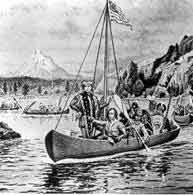
Jefferson proposed that a group of explorers travel across North America in search of such a waterway. Meriwether Lewis and William Clark led the exploration west from 1803 to 1806. They discovered that the Rocky Mountains divided the land. They also found no coast-to-coast waterway.
So Jefferson decided that a different transportation system would best connect American communities. This system involved roads, rivers and railroads. It also included the digging of waterways.
VOICE TWO:
By the middle of the 1800s, dirt roads had been built in parts of the nation. The use of river steamboats increased. Boats also traveled along man-made canals which strengthened local economies.
The American railroad system began. Many people did not believe train technology would work. In time, railroads became the most popular form of land transportation in the United States.
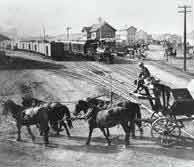
In 19th-century American culture, railroads were more than just a way to travel. Trains also found their way into the works of writers like Ralph Waldo Emerson, Nathaniel Hawthorne and Walt Whitman.
VOICE ONE:
In 1876, the United States celebrated its 100th birthday. By now, there were new ways to move people and goods between farms, towns and cities. The flow of business changed. Lives improved.
Within those first 100 years, transportation links had helped form a new national economy.
(MUSIC: "I've Been Working on the Railroad")
VOICE TWO:
Workers finished the first coast-to-coast railroad in 1869. Towns and cities could develop farther away from major waterways and the coasts. But, to develop economically, many small communities had to build links to the railroads.
Railroads helped many industries, including agriculture. Farmers had a new way to send wheat and grain to ports. From there, ships could carry the goods around the world.
Trains had special container cars with ice to keep meat, milk and other goods cold for long distances on their way to market.
People could now get fresh fruits and vegetables throughout the year. Locally grown crops could be sold nationally. Farmers often hired immigrant workers from Asia and Mexico to plant, harvest and pack these foods.
VOICE ONE:
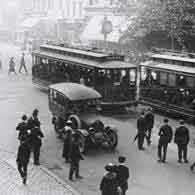
By the early 1900s, American cities had grown. So, too, had public transportation. The electric streetcar became a common form of transportation. These trolleys ran on metal tracks built into streets.
Soon, however, people began to drive their own cars. Nelson Jackson and his friend, Sewall Crocker, were honored as the first to cross the United States in an automobile. Their trip in 1903 lasted 63 days. And it was difficult. Mainly that was because few good roads for driving existed.
But the two men, and their dog Bud, also had trouble with their car and with the weather. Yet, they proved that long-distance travel across the United States was possible. The trip also helped fuel interest in the American automobile industry.
VOICE TWO:
By 1930, more than half the families in America owned an automobile. For many, a car became a need, not simply an expensive toy. To deal with the changes, lawmakers had to pass new traffic laws and rebuild roads.
Cars also needed businesses to service them. Gas stations, tire stores and repair centers began to appear.
Many people took to the road for personal travel or to find work. The open highway came to represent independence and freedom. During the 1920s and 30s, the most traveled road in the United States was Route 66. It stretched from Chicago, Illinois, to the Pacific Ocean in Santa Monica, California. It was considered the "people's highway."
VOICE ONE:
The writer John Steinbeck called Route 66 the "Mother Road" in his book "The Grapes of Wrath." Hundreds of thousands of people traveled this Mother Road during the Great Depression of the 1930s. They came from the middle of the country. They moved West in search of work and a better life.
In 1946, Nat King Cole came out with this song, called "Route 66."
(MUSIC: "Route 66")
VOICE TWO:
World War Two ended in 1945. Soldiers came home and started families. Businesses started to move out to the edges of cities where suburbs were developing. Most families in these growing communities had cars, bicycles or motorcycles to get around. Buses also became popular.
The movement of businesses and people away from city centers led to the economic weakening of many downtown areas. City leaders reacted with transportation projects designed to support downtown development.
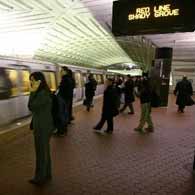
Underground train systems also became popular in the 1950s. Some people had enough money to ride on the newest form of transportation: the airplane.
VOICE ONE:
But for most automobile drivers, long-distance travel remained somewhat difficult. There was no state-to-state highway system. In 1956 Congress passed a law called the Federal-Aid Highway Act. Engineers designed a 65,000-kilometer system of roads. They designed highways to reach every city with a population over 100,000.
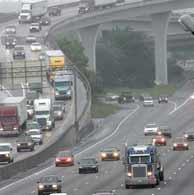
The major work on the Interstate Highway System was completed around 1990. It cost more than 100,000 million dollars. It has done more than simply make a trip to see family in another state easier. It has also led to the rise of the container trucking industry.
(MUSIC: "Truckin")
VOICE TWO:
The American transportation system started with horses and boats. It now includes everything from container trucks to airplanes to motorcycles. Yet, in some ways, the system has been a victim of its own success.
Many places struggle with traffic problems as more and more cars fill the roads. And a lot of people do not just drive cars anymore. They drive big sport utility vehicles and minivans and personal trucks.
For others, hybrid cars are the answer. Hybrids use both gas and electricity. They save fuel and reduce pollution. But pollution is not the only environmental concern with transportation. Ease of travel means development can spread farther and farther. And that means the loss of natural areas.
Yet, every day, Americans depend on their transportation system to keep them, and the largest economy in the world, on the move.
VOICE ONE:
The National Museum of American History in Washington, D.C. has a transportation exhibition that explores the connection to the economic, social and cultural development of the United States. You can experience it all on the Internet at americanhistory.si.edu. Again, the address is americanhistory.si.edu. (americanhistory.si.edu/onthemove/exhibition)
(MUSIC)
VOICE TWO:
Our program was written by Jill Moss and produced by Caty Weaver. I'm Faith Lapidus.
VOICE ONE:
And I'm Shirley Griffith. Join us again next week for the VOA Special English program THIS IS AMERICA.
Going the distance on America's highways
A trip along the Potomac river, one of America's most historic waterways
White sands national monument: a wonder of nature
Christmas 2009 in America: a joyful season in not so joyful times
(来源:VOA 编辑:陈丹妮)
